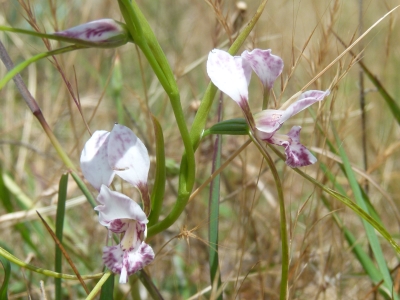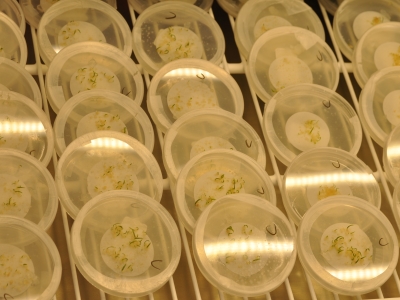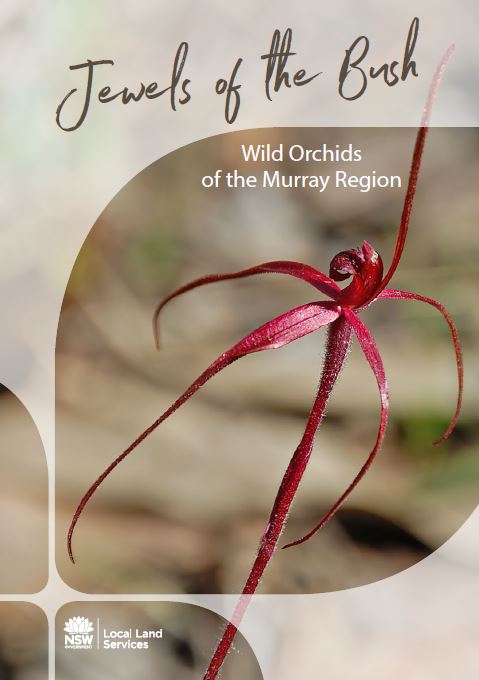Wild Orchids Project
Orchids are among the most beautiful and mysterious of all Australian native flowering plants. These jewels of the bush are important and striking additions to local biodiversity. Australia hosts over 1,700 species, but many face extinction without proper management.
The Wild Orchids Project will contribute to the long-term viability of three endangered orchid species: the Sand-hill Spider Orchid (Caladenia arenaria), Crimson Spider Orchid (Caladenia concolor), and Oaklands Donkey Orchid (Diuris callitrophila).

About wild orchids
The Crimson Spider Orchid is listed as endangered in NSW & vulnerable nationally. It is found in regrowth woodland on granite ridge country in southern NSW and north-east Victoria. The Crimson Spider Orchid is characterised by five long deep purplish-red spreading petals and sepals around a broad down-curled labellum (‘lip’). The key pollinator of the crimson spider orchids are male thynnine wasps (Chilothynnus sp.).
Sand-hill Spider Orchids are found in a handful of sandhill habitats among native pines in NSW. The Sand-hill Spider Orchid is endangered, with only a few thousand plants remaining in the wild in NSW and Victoria. It has five long, spreading pale yellow petals and sepals with red tips around a broad down-curled labellum (‘lip’). It deceives a thynnine wasp into pollinating it and its seed only germinates symbiotically in the presence of a fungal partner.
Oaklands Diuris is endangered in NSW and is currently only found on a few sandy loam soil sites on the Oaklands-Urana region. The Oaklands Diuris has up to nine white and purple flowers per flower-stem which are slightly to strongly fragrant. The key pollinator of the Oaklands Diuris is a blue-banded bee (Amegilla sp.).
Monitoring in 2014 indicated that there were less than 2000 Sand-hill Spider Orchids, less than 75 Crimson Spider Orchids and less than 1000 Oaklands Diuris Orchids left in the wild. This project aims to increase the population sizes of all three orchids species to 3000 plants each.
What is the project doing for threatened wild orchids?
- New populations of orchids are being established by propagating seed from the remaining remnant populations and planting into new secured sites.
- Invasive grasses and weeds are being controlled at all known remnant sites.
- Thinning of cypress pine is being undertaken at some remnant sites.
- Rabbit and stock proof fencing is being installed at new sites and maintained at remnant sites to prevent grazing of orchids.
- Monitoring is undertaken at all known remnant sites and new translocation sites.
- Research into key pollinators and orchid propagation methods is being supported by the project.

What can you do to help wild orchids & their habitat?
- Avoid soil disturbance – one of the main threats to orchids is inadvertent damage from track maintenance (vehicle, bike and walking tracks).
- Weed control – annual exotic grasses, st john’s wort and gazania will out-compete native orchids.
- Manage herbivores – newly germinated orchids are easily grazed out by native and introduced herbivores (rabbits, feral goats, kangaroos, livestock).
Project Achievements
Reducing threats
- Weed control (gazania, African lovegrass, boxthorn, St john’s wort)
- Fencing to exclude livestock, feral and native herbivores
- White cypress pine ecological thinning
- Firebreak maintenance
- Irrigation systems established on reintroduction sites
Increasing population
- Wild population of Crimson Spider Orchids discovered at Benambra National Park
- Wild population of Oaklands Donkey Orchid found at Urana TSR
- Five translocation enclosures built (1.5 m high fencing, water tanks)
- Six sites planted out with 6,130 orchids (1,683 Caladenia arenaria, 431 Caladenia concolor, and 4,016 Diuris callitrophilla)
Community involvement & capacity building
- Factsheets developed
- Wild orchids poster
- 'Jewels of the bush' booklet
- 25 events
- 32 media/awareness-raising products developed
Increasing ecological knowledge
- Baseline ecological data – identification of suitable translocation sites
- Identified key pollinators species for all three orchids
- Isolated mycorrhizal fungi
- Increased knowledge of orchid propagation
More Information
For more information about the project, please get in touch with:
- Shanna Rogers on 0457 733 261 or shanna.rogers@lls.nsw.gov.au
- Tracy Michael on 0427 468 489 or tracy.michael@lls.nsw.gov.au
For more detailed information on each of the threatened wild orchid species, please visit their NSW Government threatened species profiles:
A video on the work being undertaken for the conservation of the Oaklands Diuris can be found here
News articles on project progress:
- 'Jewels of the bush' returned in Australia's largest orchid translocation project - Oct 2022
- Rare orchid near Urana now protected - Dec 2021
- Protecting endangered orchids on a Urana TSR - Nov 2021
- 2020 What a Year ... for Orchids - Nov 2020
- Endangered orchid introduction into Woomargam National Park - May 2020
Jewels of the Bush: Wild Orchids of the Murray Region
Download your copy of the Jewels of the Bush: Wild Orchids of the Murray Region booklet here.
This booklet has been prepared to aid the identification of a selection of native orchids in the NSW Murray region.
Project Partners
This project is delivered in collaboration with the NSW Department of Planning, Industry & Environment – Conservation & Biodiversity Division, Department of Primary Industries - Lands, orchid specialists at Royal Botanic Gardens Melbourne and the Australian Network for Plant Conservation, Forestry Corporation of NSW, NSW National Parks and Wildlife Service, Local Government, Parklands Albury Wodonga and landholders.
Murray Local Land Services support this project through the NSW Environmental Trust funding.
